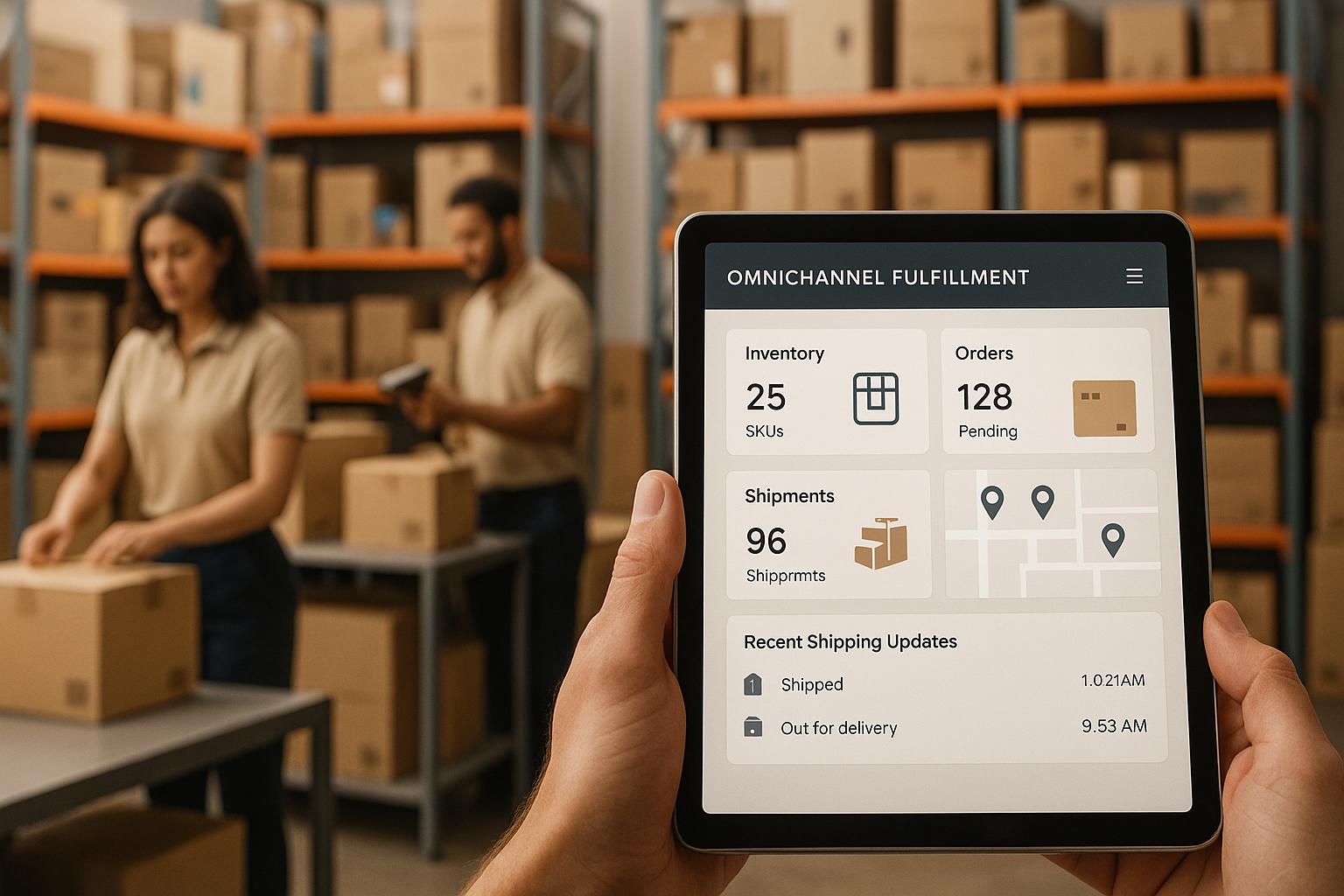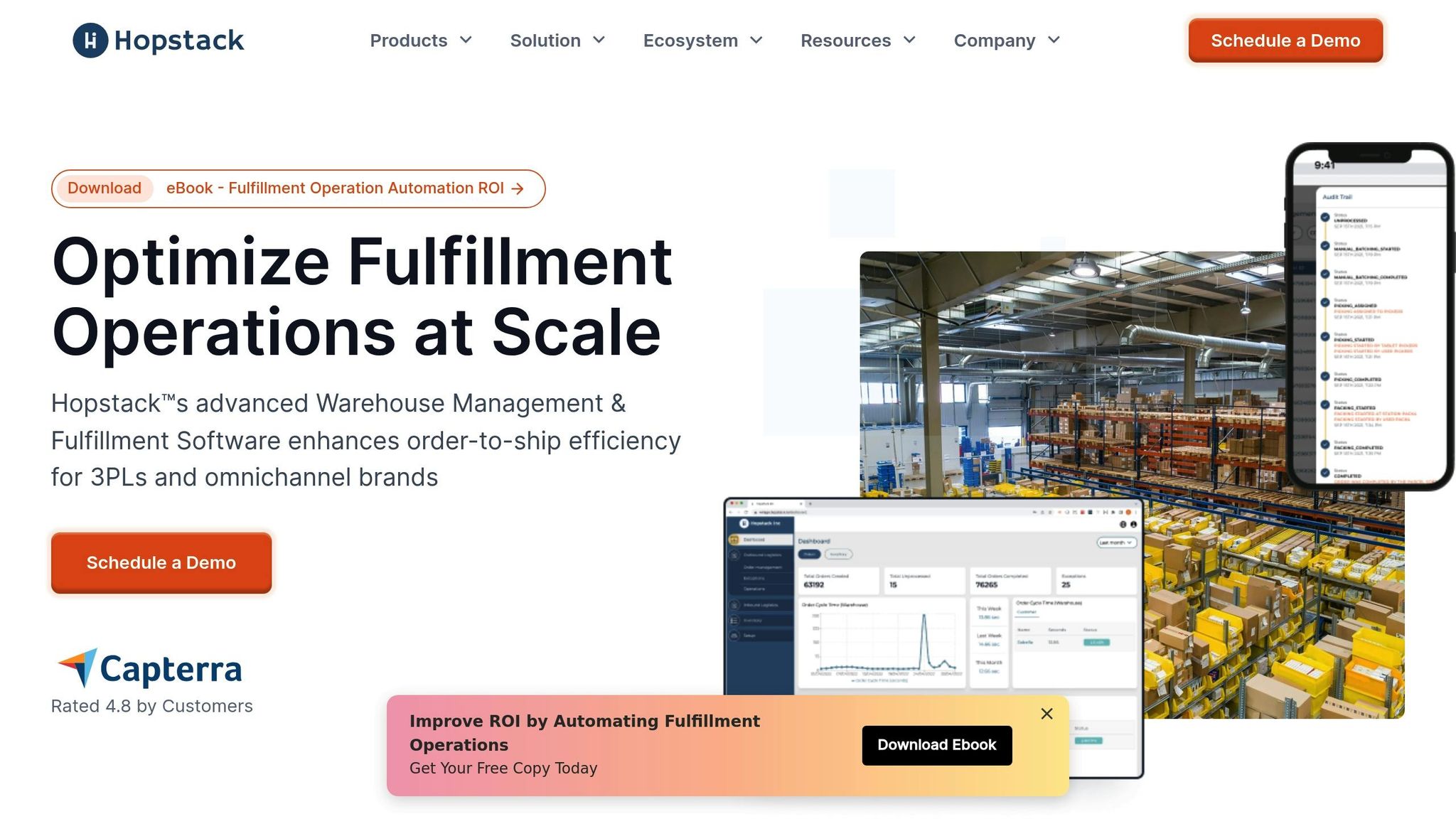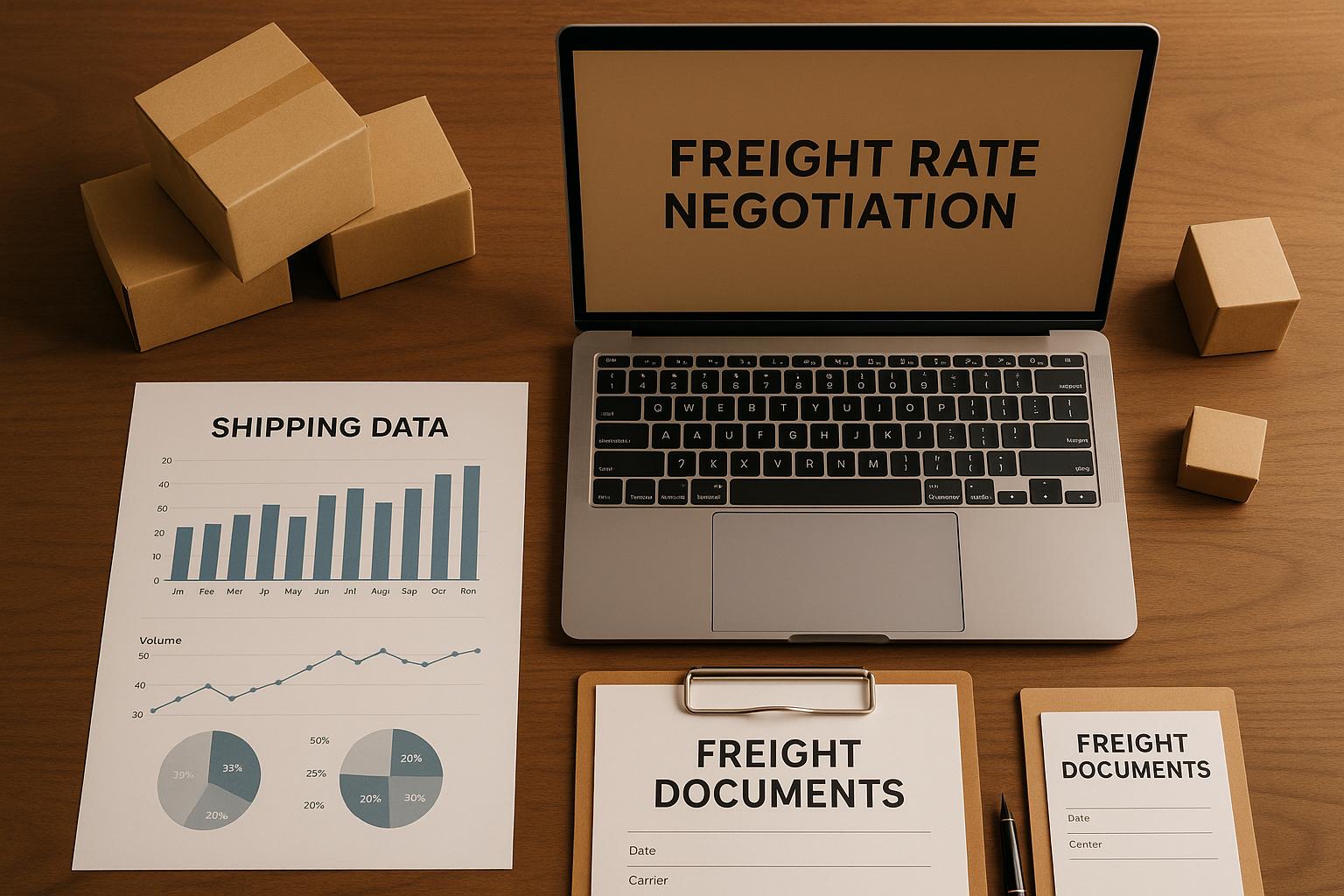How 3PLs Support Omnichannel Fulfillment

Omnichannel fulfillment connects inventory and order processing across all sales channels, ensuring a smoother shopping experience for customers. Third-party logistics (3PL) providers play a key role in making this possible by managing complex operations, offering advanced technology, and improving inventory management. Here’s how they help:
- Simplify Fulfillment: 3PLs handle orders from online stores, mobile apps, physical locations, and more - ensuring accurate and efficient processing.
- Improve Inventory Management: Using centralized systems, they keep stock levels updated in real-time, reducing overselling and stockouts.
- Enhance Shipping: They optimize delivery routes and warehouse locations, cutting costs and speeding up delivery times.
- Streamline Returns: 3PLs manage hassle-free returns, improving customer satisfaction and loyalty.
- Leverage Technology: Tools like Warehouse Management Systems (WMS) and real-time tracking improve efficiency and decision-making.
With 57% of US e-commerce companies relying on 3PLs, these providers are essential for businesses aiming to meet customer expectations while staying competitive.
Barcodes and Hopstack Webinar | 3PL Omnichannel Fulfillment Challenges

How 3PL Providers Enable Omnichannel Fulfillment
Third-party logistics (3PL) providers play a critical role in omnichannel fulfillment, with 57% of US e-commerce companies relying on them to connect online, mobile, and physical retail channels seamlessly.
Managing multiple sales channels - ranging from online stores and mobile apps to physical locations and third-party marketplaces - can be a logistical headache for many retailers. Most don’t have the in-house expertise or resources to handle such complexity. That’s where 3PL providers step in, offering the infrastructure, technology, and operational expertise needed to create smooth customer experiences across all platforms. Let’s dive into how they simplify these challenges and help retailers perform better.
Managing Complex Fulfillment Operations
Omnichannel fulfillment isn’t as simple as shipping products. It involves juggling a mix of processes, from handling single-item consumer orders to managing bulk shipments for businesses, while also optimizing inventory distribution and streamlining returns across multiple sales channels.
Orders from different channels often require specific handling. For instance, direct-to-consumer orders might need individual packaging and fast shipping, while wholesale orders could involve bulk packaging with scheduled delivery times. 3PLs simplify these operations using advanced software that automatically routes orders to the right fulfillment process, ensuring everything runs efficiently.
Inventory management is another critical piece of the puzzle. To meet the demands of various fulfillment methods - like buy-online-pickup-in-store (BOPIS), same-day delivery, or standard shipping - products must be strategically distributed across multiple locations. 3PLs use unified inventory systems to ensure stock is available where and when it’s needed.
Returns management adds an extra layer of complexity. For example, a product purchased online might be returned in-store, while an in-store purchase could be sent back by mail. 3PLs create unified returns processes to handle these scenarios efficiently, maintaining inventory accuracy and keeping customers happy. By taking care of these intricate details, 3PLs help retailers deliver a seamless omnichannel experience.
Acting as Partners for Retailers
3PL providers don’t just handle logistics - they act as strategic partners, helping retailers improve their operations and grow their businesses. By offering scalable logistics solutions, advanced analytics, and better shipping rates through bulk negotiations, 3PLs allow retailers to focus on their core strengths.
These providers essentially become an extension of the retailer’s team, offering insights drawn from working with a variety of industries and clients. Their expertise often surpasses what in-house teams can achieve on their own. For example, 3PLs deliver valuable analytics to address omnichannel challenges, helping retailers make smarter decisions.
One of the key benefits of partnering with a 3PL is scalability. Retailers can expand their operations without making heavy capital investments. With warehouse vacancy rates hovering at just 4.7% nationally, finding and maintaining facilities independently can be both expensive and difficult. 3PLs solve this problem by providing access to shared resources, including warehouse space and transportation networks.
Additionally, 3PLs invest in advanced systems that integrate directly with retailers’ platforms, ensuring logistics run smoothly and align with existing operations. This seamless coordination ultimately leads to better customer satisfaction across all channels.
The value of these partnerships is evident in real-world examples. Curtis Martin, Senior Operations Manager at Synnex, highlights the impact of working with a reliable 3PL:
"JIT sets the bar high in logistics. Their on-time performance, ability to handle last-minute requests, and expertise in material handling are game-changers for us. Add to that their competitive pricing and professional service, and it's clear why they're one of our most valued partners."
Inventory Management Across Multiple Channels
Managing inventory across multiple channels is no small feat, especially as businesses expand their digital presence. With 81% of retailers planning to grow their digital channels and the average business now selling on four different platforms, keeping track of stock has never been more challenging. Surprisingly, 43% of businesses still rely on manual tracking - or worse, don't track inventory at all. This makes the task even more daunting.
This is where 3PL providers step in, offering advanced inventory systems that consolidate stock data into one centralized platform. These systems provide real-time syncing of inventory across channels, ensuring businesses avoid overselling and fulfill orders with precision. This level of organization is critical, as poor inventory management has resulted in $362 billion in overstocks and a staggering $1 trillion in missed revenues. By streamlining stock control, 3PLs help businesses maintain optimal inventory levels and sidestep these costly pitfalls.
Advanced Technology Tools
To tackle the complexities of multi-channel inventory, modern 3PLs rely on cutting-edge software. Tools like Warehouse Management Systems (WMS) and Order Management Systems (OMS) work together to provide a complete overview of inventory movement, demand trends, and fulfillment needs.
These systems also excel at multi-location inventory control. Instead of treating warehouses as separate entities, they allocate stock intelligently based on factors like demand and shipping costs. For instance, if an East Coast warehouse is running low on a popular item while a West Coast facility has surplus, the system can redirect orders to balance stock and speed up fulfillment. Automation further simplifies tasks such as reordering, stock updates, and label printing. In fact, by 2024, 37% of retailers had adopted automated inventory tools to improve efficiency and reduce errors.
Real-world examples highlight the impact of these tools. In Q3 2024, APS Fulfillment used advanced WMS technology to automate operations, cutting order processing time by 97% and saving $40,000 in integration costs. Similarly, Averitt Express reduced labor costs by 25% in 2024 by implementing comprehensive WMS solutions, saving 60 hours of picking labor daily while elevating customer satisfaction.
Real-Time Inventory Updates
Real-time inventory updates are the backbone of effective omnichannel fulfillment. Whenever a customer makes a purchase on any platform, inventory levels are updated instantly across all channels.
This has a direct impact on customer satisfaction. According to IBM Research, 81% of shoppers base their purchasing decisions on stock availability, and 66% actively avoid stores that don't have nearby stock. Real-time updates help businesses build trust by providing customers with reliable product availability information.
Operationally, real-time tracking minimizes risks, streamlines processes, and boosts profitability. During high-demand periods, such as the holiday shopping season, up-to-the-minute data allows businesses to adjust inventory quickly. For example, if sales spike in a particular region, stock can be reallocated to ensure popular items remain available and delivery times stay competitive.
This visibility also improves forecasting and supply chain planning. By analyzing demand trends and seasonal patterns, businesses can prepare for shifts in demand rather than scrambling to react to shortages or surpluses. Integration with shipping software further enhances efficiency by automating tasks like label creation, package tracking, and carrier rate comparisons.
E-commerce businesses that embrace robust fulfillment strategies have seen tangible results, including a 13% drop in out-of-stock rates and a 24% improvement in inventory turnover on average. These real-time updates not only ensure accurate stock levels but also enhance the overall shopping experience, making them a cornerstone of successful omnichannel retail.
Shipping and Transportation Solutions
Shipping and transportation are the backbone of any successful omnichannel strategy. A robust shipping network paired with smart routing systems ensures quick and dependable fulfillment across channels.
One key factor in achieving this is strategic warehouse placement. By positioning warehouses in cost-effective locations, businesses can maintain fast delivery speeds while keeping expenses in check. For instance, in July 2025, a logistics provider reported reaching 96% of Americans within two days using ground shipping - an impressive feat made possible by avoiding high-cost urban hubs.
Routing technology also plays a pivotal role in streamlining operations. Advanced Order Management Systems (OMS) use smart algorithms to assign orders to the best fulfillment center based on factors like customer proximity, available inventory, and shipping costs. Take the example of an apparel brand in April 2025: the OMS automatically routed a New York customer’s order to the nearest fulfillment center instead of a distant facility, resulting in faster delivery.
To further enhance efficiency, many third-party logistics (3PL) providers operate cross-docking locations. These facilities minimize storage time, cut costs, and keep goods moving swiftly. Combined with real-time visibility tools, this approach allows companies to adapt quickly to shifting customer demands and locations. Some logistics providers have even achieved on-time delivery rates as high as 98%, showcasing the effectiveness of these strategies in meeting diverse order needs.
Custom Transportation Services
3PL providers offer a wide range of transportation solutions tailored to meet the unique demands of businesses operating across multiple channels. These services include full truckload (FTL) shipments for large orders and less-than-truckload (LTL) options for smaller quantities, ensuring cost-effective delivery for orders of any size.
JIT Transportation, for example, provides specialized services like local delivery, full truckload options, and white glove handling. White glove services are especially valuable for businesses dealing with high-value or delicate items, offering perks like inside delivery, unpacking, assembly, and debris removal. Whether customers order online, through a mobile app, or in-store, these services ensure products arrive in pristine condition.
Additionally, access to an extensive network of carriers gives 3PL providers the flexibility to optimize shipping costs and delivery timelines for every order. This capability becomes even more critical during peak seasons or when disruptions impact specific shipping routes.
Value-Added Services
Beyond transportation, 3PLs offer a suite of specialized services that simplify fulfillment and enhance operations. Services like pick & pack, kitting, and assembly ensure accurate order processing and consistent presentation for bundled or customizable products.
JIT Transportation, for example, provides comprehensive value-added services, including pick & pack, kitting and assembly, testing, and revision upgrades. These services help businesses maintain consistent product quality and presentation across all sales channels while minimizing internal workload.
Testing and quality control are particularly important for ensuring products meet specifications before shipping. This reduces returns and boosts customer satisfaction - an essential factor for maintaining brand consistency when fulfilling orders through multiple channels.
sbb-itb-eafa320
Improving Customer Satisfaction
Third-party logistics (3PL) providers play a key role in delivering flexible and accurate fulfillment services, which are crucial for keeping customers happy. By offering diverse fulfillment options and efficient returns processes, 3PLs help businesses go beyond customer expectations across all sales channels.
The numbers tell the story: companies that provide three or more fulfillment options see 3.5 times better customer engagement. This is why businesses increasingly depend on 3PL providers to expand their capabilities beyond standard shipping methods. Alongside flexible fulfillment, streamlined returns processes further strengthen customer loyalty.
Flexible Fulfillment Options
Today’s shoppers expect convenience and choice. Fulfillment options like home delivery, buy online pick up in-store (BOPIS), curbside pickup, or locker services - all supported by 3PL providers - ensure a seamless shopping experience, no matter where the purchase begins.
Big retailers are leading the way with these strategies. Walmart connects its physical stores, online platform, and mobile app, letting customers browse online, order through the app, and choose between home delivery or in-store pickup. Similarly, Target uses an omnichannel approach, combining its stores and online platform to offer BOPIS and same-day delivery services.
When customers can easily switch between options like online ordering and in-store pickup - or opt for same-day delivery - they’re more likely to stick with a brand. 3PL providers make this possible by managing inventory across multiple locations and coordinating fulfillment operations.
Geographic positioning also plays a major role. By strategically locating inventory closer to customers, 3PLs enable businesses to reach new markets and speed up shipping. This not only reduces delivery times but also keeps costs manageable, which directly enhances customer satisfaction.
Take JIT Transportation as an example. Their fulfillment services adapt to customer needs, offering everything from standard delivery to white-glove handling for delicate items. They even provide specialized assembly services. This level of flexibility creates a better shopping experience and extends naturally to efficient returns handling.
Returns Management
A smooth returns process is just as important as flexible delivery. In fact, 92% of customers are likely to repurchase if returns are easy, and 84% say a positive returns experience encourages them to shop with the same retailer again. These stats show how much returns impact customer loyalty.
On the flip side, poor returns management can hurt a business. 88% of customers say they’d stop or limit shopping with a retailer if refunds take too long, and 77% are less likely to recommend a retailer if refund delays occur. With ecommerce return rates hitting 20% to 30% for apparel and accessories, efficient returns processes are essential.
3PL providers simplify returns by using automation, optimized layouts, and standardized inspections. These tools speed up refunds and get returned items back on shelves faster, which directly improves customer satisfaction. For example, automated returns systems can cut labor costs by 25-30% compared to manual handling, allowing businesses to reinvest in customer service.
Rick Nelson, CEO of The Fulfillment Lab, highlights why returns are a strategic opportunity:
"For ecommerce retailers, it's more difficult to create meaningful connections with online shoppers. Allowing customers to return previously purchased products is a simple way to build stronger, long-lasting relationships with them. It's important to view returns not as a loss, but as an opportunity. Providing considerate, accessible, and visible product return experiences to customers wishing to make a return greatly impacts their view of your business – and your overall reputation."
Currently, 40% of retailers rely on 3PL providers for returns management. These providers bring specialized expertise, offering services like refurbishment, repackaging, and secondary market management. This helps businesses recover value from returned items while keeping customers satisfied.
The tech infrastructure from 3PLs - like cloud-based warehouse management systems (WMS), real-time tracking, and mobile scanning - adds transparency to the returns process. Customers receive updates on return status, refunds, and credit timelines, reducing frustration and building trust.
JIT Transportation takes this further with their RMA services, ensuring fast returns processing and accurate inventory reconciliation. This systematic approach helps businesses maintain strong customer relationships while easing the operational challenges of returns.
Clear communication, hassle-free returns, and package tracking are key to successful returns management. When 3PL providers handle these elements effectively, businesses enjoy higher customer retention and positive word-of-mouth, giving them a competitive edge in crowded markets.
Using Technology and Data Analytics
Today’s 3PL providers rely heavily on digital tools and real-time analytics to make omnichannel fulfillment more efficient. These technologies transform raw data into actionable insights, enabling smarter decisions and smoother operations across all sales channels.
One of the biggest challenges in supply chain management is data visibility. Surprisingly, only 2% of businesses have full visibility beyond their second-tier suppliers, yet 66% of supply chain leaders consider data analytics essential for their future success. This gap is a major reason why many businesses are turning to 3PL providers that have invested in advanced analytics.
The backbone of effective omnichannel fulfillment is accurate, up-to-date information flowing seamlessly across systems. AI-powered tools, for example, can increase productivity by 58% and streamline operations. These technologies provide the real-time insights and continuous improvements needed to keep fulfillment processes agile and efficient.
Real-Time Data Insights
3PL providers use a range of tracking technologies to monitor every step of the supply chain. Tools like GPS tracking, RFID sensors, IoT devices, and warehouse management systems (WMS) work together to give full visibility into inventory movement, shipping updates, and operational performance. For instance, dispatchers can reroute drivers to avoid traffic jams or handle last-minute delivery cancellations.
IoT sensors play a critical role in managing temperature-sensitive goods, such as those in the pharmaceutical or food industries. These sensors constantly monitor conditions like temperature and humidity, ensuring products remain safe. If irregularities are detected, the system sends an immediate alert, allowing staff to fix the issue before any damage occurs.
A great example of the benefits of real-time updates comes from C&S Wholesale Grocers, which cut customer service calls by 65% after providing live updates on truck locations and arrival times. This level of transparency not only enhances trust but also reduces the burden on customer service teams, improving the overall customer experience.
Real-time analytics also strengthen risk management by identifying potential disruptions early. These insights help 3PL providers address issues before they escalate, protecting both their operations and their clients’ customer relationships. For example, analytics can guide inventory placement and shipping adjustments, ensuring a seamless omnichannel experience.
JIT Transportation showcases this approach by integrating advanced tracking systems across its network. Their technology allows clients to monitor inventory levels, shipment progress, and delivery updates in real time. This visibility empowers clients to make proactive decisions and fosters better communication with their customers.
Continuous Operations Improvement
Beyond real-time tracking, data analytics drive continuous improvements in operations. Predictive analytics and machine learning provide powerful tools for forecasting demand and identifying potential disruptions before they occur.
According to McKinsey, data analytics can reduce forecasting errors by 20–50%. This improvement helps 3PL providers manage inventory more effectively, cutting costs and preventing issues like stockouts or overstocking. Considering that stockouts alone cause retailers to lose about 4% of their revenue, accurate demand forecasting is a game-changer.
To achieve this, 3PL providers analyze data from various sources, including sales history, seasonal patterns, promotional schedules, and market trends. This multi-faceted approach results in more reliable forecasts that benefit both retailers and their customers.
Machine learning plays a key role in spotting anomalies, such as supplier delays, equipment malfunctions, or unexpected demand changes. Early warnings from these systems enable 3PL providers to implement contingency plans, keeping disruptions from affecting customer orders.
In practice, predictive analytics have shown real-world success. For example, a global brake parts manufacturer uses these tools to adjust planning based on live data about brake failures, ensuring timely part deliveries and avoiding delays. Similarly, a tier one tire supplier relies on real-time flow data to prevent shipment delays and improve inventory planning.
The adoption of AI in supply chain management is growing rapidly. Gartner predicts that by 2026, half of all supply chains will invest in AI technologies, underscoring their value in reducing costs and boosting efficiency.
JIT Transportation exemplifies how analytics can drive continuous improvement. By leveraging data-driven insights, they identify ways to enhance efficiency, anticipate maintenance needs, and allocate resources more effectively. This approach not only keeps costs in check but also ensures reliable, customer-focused fulfillment that aligns with omnichannel strategies businesses depend on.
Conclusion: 3PLs Drive Omnichannel Success
Third-party logistics providers (3PLs) play a key role in overcoming the challenges of omnichannel fulfillment. Businesses that partner with 3PLs offering omnichannel solutions are 270% more likely to experience revenue growth, showcasing the tangible benefits these partnerships bring.
The modern retail environment is more demanding than ever. With 44% of consumers expecting two-day delivery and 77% prioritizing convenience and free shipping when shopping online, fulfillment operations face mounting pressure to deliver. Yet, only 45% of consumers feel their delivery speed expectations are met. This gap is where 3PLs step in, equipped to close the distance between consumer expectations and operational realities.
Providers like JIT Transportation lead the way by combining expertise, advanced technology, and adaptable solutions. Their services cover every aspect of fulfillment, from real-time inventory tracking across multiple channels to custom transportation options that ensure fast and cost-effective delivery. By integrating cutting-edge systems with tailored logistics strategies, 3PLs enable businesses to deliver a seamless omnichannel experience.
Partnering with a 3PL allows businesses to focus more on core priorities like product innovation and marketing, all while maintaining high standards of customer service. Hal Shapiro from Seagate Technology highlights this benefit:
"JIT has been a trusted logistics partner for Seagate for years, and their reliability is unmatched. Day in and day out, they prove their commitment to seamless operations, ensuring our supply chain stays on track. We know we can count on JIT to deliver, every time."
For fast-growing e-commerce brands, working with a 3PL provides a strategic edge. As 75% of retailers now allow in-store returns for online purchases and 76% use store inventory to fulfill online orders, operational complexity continues to rise. 3PLs offer the infrastructure and expertise necessary to manage these complexities while ensuring customer satisfaction remains a top priority.
FAQs
How do 3PL providers work with retailers to streamline omnichannel fulfillment?
When it comes to omnichannel fulfillment, 3PL providers take the lead by connecting directly with a retailer’s systems through Warehouse Management Systems (WMS). These advanced systems sync smoothly with major e-commerce platforms like Shopify, Magento, and BigCommerce. The result? Real-time updates for inventory, order processing, and shipping across every sales channel.
This kind of integration brings big advantages: precise inventory tracking, quicker order fulfillment, and a seamless experience for customers. By using advanced technology, 3PLs enable retailers to stay efficient and keep up with the expectations of modern omnichannel shoppers.
What technologies do 3PLs use to provide real-time inventory updates, and how do these tools help retailers?
Third-party logistics providers (3PLs) use cutting-edge tools like warehouse management systems (WMS), RFID, barcode scanning, and cloud-based platforms to offer real-time inventory updates. These technologies help retailers keep track of stock accurately, minimize the chances of running out of products, and maintain the right inventory levels.
With instant access to inventory data across various channels, these tools streamline supply chain operations and enable quicker responses to demand. The result? Smoother omnichannel fulfillment and happier customers.
How can a 3PL provider enhance customer satisfaction and loyalty in an omnichannel retail strategy?
Partnering with a 3PL provider can make a huge difference for retailers aiming to provide a smooth omnichannel shopping experience. By streamlining delivery times, simplifying returns, and keeping inventory management on point, 3PLs help ensure customers have a hassle-free journey - whether they’re shopping online, in-store, or using a mix of both.
On top of that, 3PL providers take on the heavy lifting of complex logistics, such as managing returns and quickly resolving customer concerns. These efforts help build trust and reliability, which naturally leads to repeat business and stronger customer loyalty. By handling these operational details, 3PLs free up retailers to focus on what matters most: delivering a consistently excellent experience across every channel.
Related Blog Posts
Related Articles

Freight Rate Negotiation for E-commerce Brands

10 Common Supply Chain Risks and How 3PLs Solve Them

